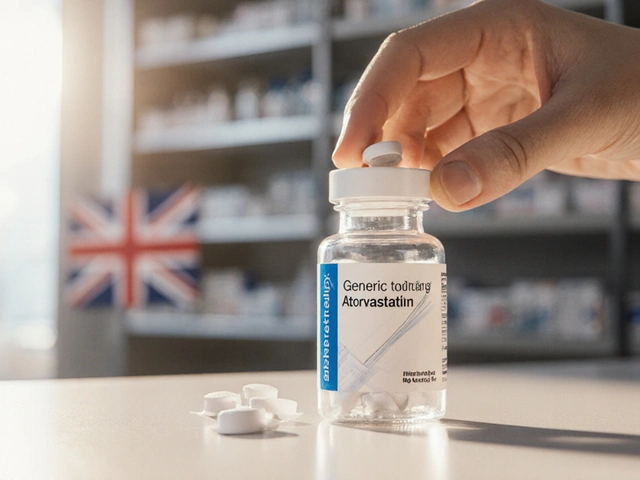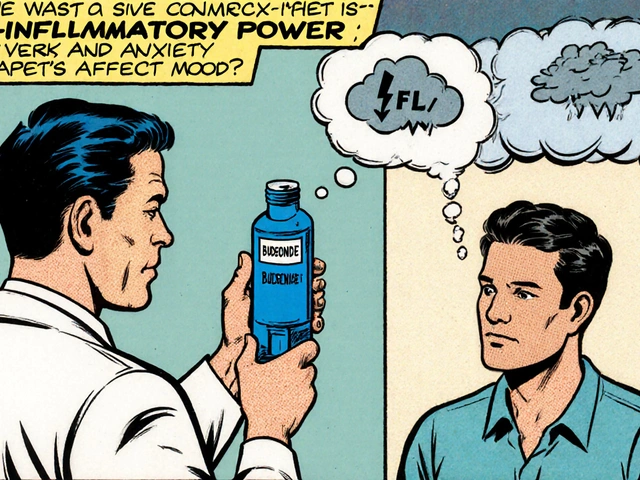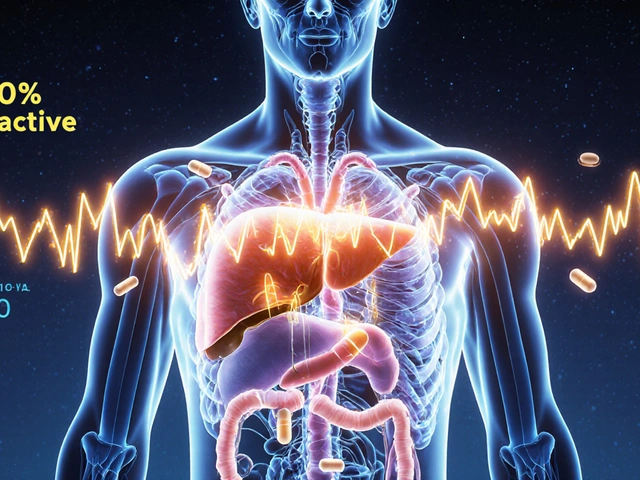TL;DR
- Dramamine is dimenhydrinate, an antihistamine that prevents motion‑sickness nausea.
- Take it 30‑60minutes before travel; repeat every 4‑6hours if needed, up to 4 doses a day.
- Adults: 50mg per dose; kids 2‑12years: 25mg (or chewable 25mg) every 6hours, max 3 doses.
- Common side‑effects: drowsiness, dry mouth, blurred vision; avoid alcohol and driving if drowsy.
- If you dislike the taste or want less drowsiness, try meclizine, ginger, or non‑medicinal tricks.
What is Dramamine?
Dramamine is the brand name for the drug dimenhydrinate. It belongs to the first‑generation antihistamine class, the same family as diphenhydramine (Benadryl). Its job is simple: stop the brain’s nausea signals that get fired off when your inner ear senses motion that your eyes don’t see.
Because it blocks histamine receptors in the vestibular system, you feel less queasy on boats, cars, planes, or even during virtual‑reality sessions. The tablets come in 50mg (adult) and 25mg chewable (children) forms, plus an Dramamine liquid for kids who can’t swallow pills.
How Dramamine Works and When to Take It
The magic happens about 30‑60minutes after you pop a dose. Dimenhydrinate spreads through the bloodstream, settles in the inner ear’s fluid‑filled canals, and dampens the overstimulation that normally tricks your brain into thinking you’re about to vomit.
Timing matters. If you take it too late, the drug won’t stop the first wave of nausea. The rule of thumb is:
- Take the full dose **before** you start moving (e.g., before boarding a ferry).
- If you’re on a long trip, set a reminder to re‑dose every 4‑6hours.
- Don’t exceed 4 adult doses in a 24‑hour period - that’s the safety ceiling.
For children, the same principle applies, just with a lower dose and a stricter cap on the number of doses.
Proper Dosage for Different Ages and Situations
Getting the dose right keeps you effective and limits drowsiness. Below is a quick‑look table you can print or bookmark.
| Age Group | Form & Strength | Typical Dose | Maximum per 24h |
|---|---|---|---|
| Adults (≥18y) | Tablet - 50mg | 1 tablet every 4‑6h | 4 tablets (200mg) |
| Teens (12‑17y) | Tablet - 50mg | ½‑1 tablet every 6h | 2 tablets (100mg) |
| Children (2‑11y) | Chewable - 25mg | 1 chewable every 6h | 3 chewables (75mg) |
| Infants (<2y) | Not recommended | - | - |
Always double‑check the label - some overseas versions use 25mg tablets, which changes the math. If you’re unsure, ask a pharmacist.

Common Side Effects & Safety Warnings
Dramamine is generally safe, but it isn’t a free‑pass to ignore your body. The most frequent reactions are:
- Drowsiness - the reason why you shouldn’t drive or operate machinery after a dose.
- Dry mouth or throat.
- Blurred vision or difficulty focusing.
- Constipation or urinary retention (rare).
Serious side effects are uncommon but worth spotting early:
- Rapid heartbeat, palpitations.
- Severe allergic reaction - swelling, hives, trouble breathing.
- Confusion or hallucinations (usually in the elderly).
Key safety tips:
- Never mix with alcohol or other sedating meds (e.g., sleep aids, antihistamines).
- If you have glaucoma, asthma, an enlarged prostate, or a history of seizures, talk to a doctor first.
- Pregnant or breastfeeding? The data is limited, so get professional advice.
- Store the tablets in a cool, dry place. The liquid form can lose potency if it gets too warm.
Alternatives When Dramamine Isn’t Your Cup of Tea
Not all travel companions love the taste or the drowsy feeling. Here are other options that work for motion‑sickness:
- Meclizine (Bonine) - another antihistamine with less sedation; good for longer trips.
- Scopolamine patch - a prescription patch placed behind the ear, ideal for sea travel.
- Ginger capsules or candied ginger - natural, non‑sedating, handy for mild cases.
- Acupressure wristbands - pressure on the P6 point; evidence is mixed but many find it helpful.
- Behavioral tricks: stare at the horizon, sit in the front seat of a car, keep your head still with a travel pillow.
When choosing an alternative, consider the trip length, how drowsy you can be, and any medical conditions you have. For example, scopolamine isn’t ideal if you’ve had glaucoma, while meclizine may be safer for senior travelers.
FAQ - Quick Answers to Common Questions
- Can I take Dramamine on an empty stomach? Yes, but taking it with a light snack can reduce stomach upset.
- How long does the effect last? Roughly 4‑6hours per dose. Re‑dose as needed, respecting the max daily limit.
- Is it safe for children under 2? No. The product isn’t approved for infants; talk to a pediatrician for other options.
- Will it make me vomit less on a roller coaster? It helps with motion‑induced nausea, but the high‑G forces of a coaster can still overwhelm the drug.
- Can I combine it with anti‑emetic pills like ondansetron? Only under a doctor’s guidance - mixing anti‑emetics can increase side‑effects.

Next Steps & Troubleshooting
If you’ve tried the recommended dose and still feel queasy, try these steps:
- Check timing - you might have taken it too late. Reset your schedule for the next segment of travel.
- Assess hydration - dehydration can worsen nausea. Sip water or an electrolyte drink.
- Swap to a less sedating alternative (meclizine) if drowsiness is the issue.
- Consult a pharmacist if you’re on other meds; they can spot dangerous interactions.
- If symptoms persist beyond 24hours or you develop a fever, seek medical attention - it might be an unrelated illness.
Armed with the right dose, timing, and safety know‑how, you can finally enjoy that cruise or road trip without the dreaded queasy loop.










Sophie Rabey
September 20, 2025 AT 22:50Ah, the dazzling world of dimenhydrinate-truly the epitome of cutting‑edge anti‑nausea science. The pharmacokinetic timeline, a mere 30‑60 minutes, is practically instantaneous in the realm of vestibular modulation. One can almost hear the histamine receptors sigh in relief as the drug cascades through the blood‑brain barrier. Of course, the dosage matrix is as elegant as a flowchart at a corporate summit, and we’re all just thrilled to follow it.
Bruce Heintz
September 21, 2025 AT 08:47Totally get it, Sophie! 😄 The timing tip is solid-pop that tablet before you board and you’ll cruise through the trip like a pro. If you ever feel a little off, just remember to hydrate and keep a gum pack handy. Keep the good vibes rolling!
richard king
September 21, 2025 AT 18:43Life, my friend, is a ceaseless sea of motion, and our inner ear the fickle compass of existence. Dimenhydrinate serves as the philosopher’s stone, transmuting nausea into tranquil silence. Yet, we must ask: does the dampening of sensory discord not also mute the raw poetry of feeling? In the grand tapestry of travel, perhaps a pinch of ginger offers a more poetic rebellion against the tide. Still, the science stands as a beacon for the weary wanderer.
Dalton Hackett
September 22, 2025 AT 04:39When considering the deployment of dimenhydrinate within the context of vestibular pharmacotherapy, one must first acknowledge the intricate balance between therapeutic efficacy and adverse effect profile. The drug’s antihistaminic mechanism, by virtue of H1‑receptor antagonism, attenuates the afferent signals arising from the otolithic organs, thereby mitigating the central perception of kinetic discord. It is paramount, however, to recognize the temporal dynamics of absorption; oral bioavailability peaks at approximately forty minutes post‑administration, a window during which the plasma concentration aligns with the therapeutic threshold.
Given the hepatic first‑pass metabolism, inter‑individual variability may yield divergent plasma levels, necessitating a judicious titration approach, especially in geriatric cohorts. Moreover, the concomitant use of alcohol or CNS depressants potentiates the sedative properties, amplifying the risk of compromised psychomotor performance – a factor not to be dismissed lightly.
From a pediatric perspective, the dosage stratification adheres to a weight‑based schema, with chewable formulations offering improved compliance yet introducing potential challenges in taste acceptance. The clinical guidelines recommend a ceiling of three doses within a twenty‑four‑hour period for children, a constraint designed to forestall cumulative anticholinergic burden.
In addition, the risk of anticholinergic toxicity, manifesting as dry mucosa, blurred vision, and urinary retention, underscores the necessity for patient education regarding symptom monitoring. Should the patient exhibit excessive somnolence, driving or operating heavy machinery must be avoided until full alertness is restored.
Alternatives such as meclizine, possessing a more favorable sedative profile, may be considered in patients with heightened sensitivity to drowsiness. Likewise, non‑pharmacologic interventions-spatial orientation cues, controlled breathing, and ginger supplementation-provide adjunctive benefit.
Ultimately, the clinician’s role is to synthesize these pharmacodynamic and pharmacokinetic variables into a personalized regimen that maximizes anti‑nausea efficacy while minimizing iatrogenic sequelae. Proper counseling, adherence to dosing intervals, and vigilant observation of side‑effects constitute the cornerstone of safe dimenhydrinate utilization.
William Lawrence
September 22, 2025 AT 14:35another thing you could try is just not moving at all
Henry Clay
September 23, 2025 AT 00:31yeah but if you keep using meds all the time its like you become dependent on chemicals it’s bad :)
Isha Khullar
September 23, 2025 AT 10:27The moral implication of reaching for a chemically induced calm is profound it reflects a surrender to modern pharmaceutics that bypasses natural resilience
Lila Tyas
September 23, 2025 AT 20:23Hey folks! If you’re gearing up for a road trip, remember to grab your Dramamine ahead of time. A quick dose 30 minutes before hitting the highway can save you from that dreaded motion‑sickness rollercoaster. Stay hydrated, keep a snack handy, and enjoy the ride! 🌟
Mark Szwarc
September 24, 2025 AT 06:20Great reminder, Lila! I’d add that setting a reminder on your phone for re‑dosing can prevent any lapse in coverage, especially on longer trips. Also, if you’re driving, make sure you’re fully alert before you get behind the wheel – the sedative effect can linger. For those who experience excessive drowsiness, consider switching to meclizine, which tends to be less impairing.
BLAKE LUND
September 24, 2025 AT 16:16From a cultural standpoint, many travelers across the globe have embraced herbal remedies like ginger and peppermint as a natural antidote to motion woes. While modern antihistamines are effective, it’s fascinating to see how age‑old traditions still hold a place in our collective travel toolkit.
Holly Hayes
September 25, 2025 AT 02:12i mean honestly who even needs a chewpable when you can just sip tea and pretend ur not queasy lol
Matthew Shapiro
September 25, 2025 AT 12:08The information presented here is comprehensive and well‑structured, offering clear guidance on dosage schedules for various age groups. It also responsibly highlights potential side effects and contraindications, which is essential for safe usage. Overall, a useful reference for both casual travelers and healthcare professionals.
Julia Phillips
September 25, 2025 AT 22:04Indeed, the balance between efficacy and safety is a delicate dance. While the antihistamine route provides rapid relief, the narrative reminds us of the importance of personalizing treatment-considering factors like age, activity level, and even personal comfort with medication taste. It’s a compelling call to both trust evidence‑based practice and honor individual experience.
Richa Punyani
September 26, 2025 AT 08:00Dear esteemed readers, it is my distinct pleasure to convey, in the most formal yet encouraging manner, the virtues of pre‑emptive antinausea strategies. Should one embark upon a maritime voyage or aerial expedition, the administration of dimenhydrinate, precisely thirty minutes prior to commencement, is most advisable. Moreover, I would be remiss not to mention the ancillary benefits of maintaining adequate hydration and the consumption of modest, bland nourishment to further fortify one’s gastrointestinal resilience. With these measures enacted, one may traverse the seas of travel with composure and grace.
Bhupendra Darji
September 26, 2025 AT 17:56Absolutely, Richa. I’d just add that for those who prefer a more holistic approach, incorporating ginger chews or peppermint tea can complement the medication, especially for short trips where dosing intervals might be inconvenient.
Robert Keter
September 27, 2025 AT 03:52When one contemplates the manifold mechanisms by which dimenhydrinate exerts its anti‑emetic influence, the scene unfolds much like an intricate theatrical production. The H1‑receptor blockade, akin to a steadfast sentinel, arrests the errant neurotransmission that would otherwise herald nausea. Yet, the drama does not end there: the drug’s anticholinergic properties gently coax the vestibular apparatus into a state of subdued harmony, tempering the discordant signals that arise from motion.
It is here, in this delicate interplay, that the traveler finds solace, albeit at the modest cost of somnolence-a price many are willing to pay for the promise of an untroubled journey. Further, the pharmacokinetic tapestry, woven over a half‑hour to an hour, ensures that the plasma concentration aligns gracefully with the therapeutic window, providing a temporal shield against queasy incursions.
Thus, while the physician’s prescription may seem succinct, the underlying symphony of biochemical events is vast and profound, deserving of both respect and careful consideration.